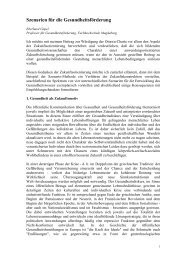Chapter 1
Chapter 1
Chapter 1
You also want an ePaper? Increase the reach of your titles
YUMPU automatically turns print PDFs into web optimized ePapers that Google loves.
at around 2 percent a year This rate is lower than the region's The public sector's financing of health care comes partly<br />
average (2.8 percent), but is still higher than other low-mid- from general tax revenues to support a national system and<br />
dle income countries (1.4 percent) and requires continued partly from public health insurance funds that receive contristrengthening<br />
of preventive medical care and family plan- butions from compulsory payroll deductions shared between<br />
ning efforts; and employers and employees. The public system is facing diffi-<br />
* Adapting services to the changing age structure and geo- culties generating sufficient revenues to cover the operational<br />
graphic distribution of the population, as declining fertility and investment costs needed to meet the quality expectations<br />
and reduced mortality rates produce an older population of the population and to compete with growing competition<br />
with an epidemiological profile with more chronic and from the private sector. Part of the reason for insufficient<br />
degenerative diseases that are more expensive to treat. financial resources is because the lump sum provided by the<br />
The Government is the main provider and financier of CNSS to the public health care system covers only an estihealth<br />
care. The private sector's role is growing, even mated 40-50 percent of the cost of services provided by pubthough<br />
the Government provides nearly half the popula- lic health care providers to the CNSS affiliates (a<br />
tion with free or highly subsidized care. In addition, the Government study is underway to determine this share more<br />
public insurance funds and the Social Security Fund precisely). The public health system is also providing free or<br />
(CNSS) do not compensate private health care providers highly subsidized care to a larger share of the population than<br />
(Social Protection System Study, 1993). Nevertheless, the is warranted based on income levels. The government needs<br />
private sector's role is growing, particularly for ambulatory to: (1) increase CNSS payments to health care providers<br />
health services (table 2.8a). Government budgetary expen- commensurate with the use of its affiliates; (2) limit the covditures<br />
on health care as a share of GDP have remained vir- erage of free assistance to the really needy and raise health<br />
tually constant at 2.2 percent since the 1980s, but health care service fees for those who can pay, as a means of encourcare<br />
costs have gone up considerably, and these increases aging people to affiliate with and contribute to the Social<br />
have had to be picked up by households (table 2.8b). The Security System; and (3) link pension and health insurance<br />
increase in household expenditures is also a reflection of benefits more closely to contributions.<br />
higher private sector participation. The Tunisian authorities have a commitment to equity in<br />
health care, yet resources are scarce and the system is suf-<br />
TABLE 2.AA fering from growing demand, insufficient funds, and con-<br />
Main providers of health care straints in maintaining quality. Mobilizing private resources<br />
(Percentae of services provided, 1 992) in addition to public funds and encouraging the private pro-<br />
Provider Hospital services<br />
Ambulatory<br />
haltkh services<br />
vision of services are necessary to increase and maintain the<br />
quality of services available. A greater role for the private<br />
Ministry of Health<br />
Social security<br />
90<br />
0<br />
50<br />
3<br />
sector can be realized only if the government actively<br />
reduces its widespread provision of free or highly subsidized<br />
Private sector<br />
No access<br />
10<br />
0<br />
47<br />
0 care, and more explicitly targets its provision of subsidized<br />
Total 100 100 services. A variety of options could be considered: increas-<br />
TABLE 2.8B<br />
ing user selected fees; privatizing certain services; and<br />
increasing the regulatory role of the state. A combination of<br />
Health expenditures state supervision with private provision of services would<br />
(Percentage of total expenditures) diversify the supply of health services, maintain quality, and<br />
Source of ependiture 1980 1992 promote the efficient use of resources.<br />
Govemment budget<br />
Social securh)<br />
51<br />
I I<br />
36<br />
48 The environment:<br />
Households<br />
Enterpise practices<br />
37<br />
I<br />
48<br />
I sustainability<br />
Tota 100 100<br />
a. The expenditure share ofthe social security funds covers its own ambulatory<br />
but only part of the services provided by the pubic sector (MOH).<br />
Source: Minstry of Health and World Bank estimates,<br />
Growth and<br />
dinics Environmental protection has long been of general concern<br />
1994. to the government, but it is only in recent years that envi-<br />
ROLE OF THE STATE IN THP ECONOMY 23

















